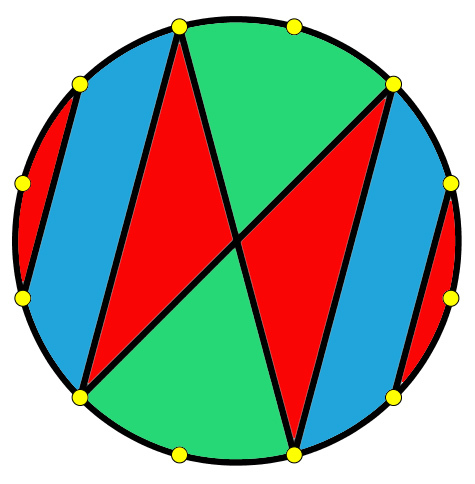Divide the arc!
The yellow points divide a circle's arc to
equal parts, as is shown in the figure.

Which area is the largest: the green, the blue or the red?
This section requires Javascript.
You are seeing this because something didn't load right. We suggest you, (a) try
refreshing the page, (b) enabling javascript if it is disabled on your browser and,
finally, (c)
loading the
non-javascript version of this page
. We're sorry about the hassle.
Assume the radius of the circle is 1. Since we are concerned with ratios, changing the radius would change all areas by the same amount relative to each other and the answer will not change. The area of the circle is given by π × r 2 , so it is π .
The green area has 1/3rd the total arc length of the circle so it takes up exactly 1/3rd of the area, 3 π .
Now let's calculate the red area in two parts. First, the hourglass shape in the middle. Let's only focus on one of those triangles. Drawing a perpendicular to create two 30-60-90 triangles, we find the area to be 3 , so the whole hourglass shape has an area of
2 ∗ 3
The curved parts of the red area can be calculated by finding the area of the sector of a circle that they are in and subtracting the triangle part. Let's just calculate 1 and multiply by two. The sector has an area of pi/6, and the triangle is equilateral and we split it into two 30-60-90 triangles to get it's area to be s q r t 3 . Therefore the area of one red curved shape is 6 π − 3 , and both form an area of twice that.
Adding these two results together we see the red area has a total area of 3 π . Since the total area of the circle is pi, we subtract red and green areas to find that the blue area is also 3 π . Therefore all areas are equal.